Compositions and methods for discovery of causative mutations in genetic disorders
a technology for genetic disorders and causative mutations, applied in the field of compositions and methods for discovering causative mutations in genetic disorders, can solve the problems of incomplete genome coverage and insufficient population sampling,
- Summary
- Abstract
- Description
- Claims
- Application Information
AI Technical Summary
Benefits of technology
Problems solved by technology
Method used
Image
Examples
example 1
[0158]Samples will be taken from at least one hundred patients with Parkinson's disease. Nucleic acid will be isolated from the samples. Array Comparative Genomic Hybridization will be used to detect copy number variants from the samples. The information on copy number variants from the samples will be inputted into a computer. The computer will compare the information on copy number variants from the sample to information in a database. The information in the database is information on the frequency of copy number variants from at least 1,000 subjects that have not been diagnosed with Parkinson's disease. The statistical significance of the correlation of Parkinson's disease with one or more copy number variants in the samples from the Parkinson's disease patients will be determined A copy number variation will be identified in a sub-population of Parkinson's disease patients that is not in the database of information on subjects that do not have Parkinson's disease.
[0159]Next, nuc...
example 2
[0160]Several assays are performed to determine if the mutation identified in Example 1 affects the function of the gene in which the mutation resides. First, a computer will be used to determine if there is a change in the amino acid sequence of the predicted protein product of the gene. Second, the mRNA expression levels of the gene will be compared in samples from patients with the mutation and in samples from subjects without the mutation. Third, an activity assay will be performed using a protein with sequence derived from a subject without the single base mutation and a protein with sequence containing the single base mutation. The assay will be used to determine if the mutation affects the activity of the protein. Fourth, X-ray crystallography can be performed on a protein with sequence derived from a subject without the mutation and on a protein with amino acid sequence derived from a patient with the mutation. This structural study will be used to determine if the mutation ...
example 3
[0161]Next, a drug screen will be performed to identify compounds that can treat Parkinson's disease with the genetic variant identified in Example 1 and validated in Example 2. Multiple compounds (e.g. up to 50,000 compounds) will be screened of which one or more candidates will be identified to treat Parkinsons disease with the genetic variant identified in Example 1 and validated in Example 2. Clinical trials will be performed and one compound will be found to be safe and effective. The one compound will be found to be efficacious in Parkinson's disease patients that have the genetic variant identified in Example 1 and not in Parkinson's disease patients that do not have the genetic variant identified in Example 1.
[0162]New Parkinson's disease patients will be screened for the mutation. A Parkinson's disease patient that has the genetic variant identified in Example 1 will be prescribed the compound.
PUM
 Login to View More
Login to View More Abstract
Description
Claims
Application Information
 Login to View More
Login to View More - R&D
- Intellectual Property
- Life Sciences
- Materials
- Tech Scout
- Unparalleled Data Quality
- Higher Quality Content
- 60% Fewer Hallucinations
Browse by: Latest US Patents, China's latest patents, Technical Efficacy Thesaurus, Application Domain, Technology Topic, Popular Technical Reports.
© 2025 PatSnap. All rights reserved.Legal|Privacy policy|Modern Slavery Act Transparency Statement|Sitemap|About US| Contact US: help@patsnap.com



